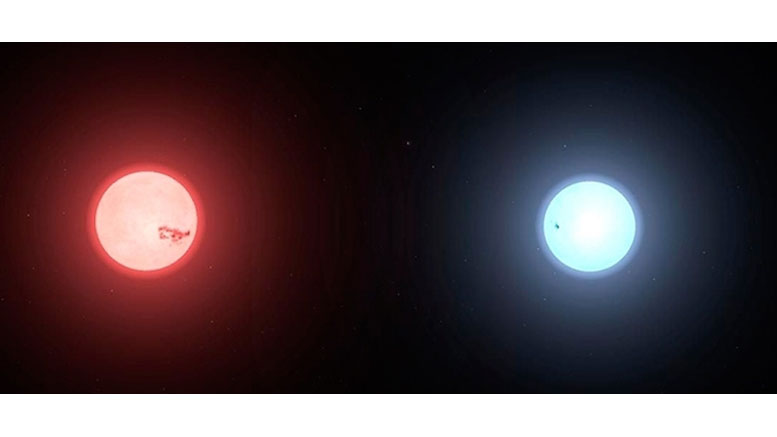
A team of Brazilian astronomers found a unique binary system consisting of a low-mass white dwarf and a brown dwarf. The white dwarf’s existence was cut short by its companion, causing its early death.
A group of astronomers in Brazilian universities and research institutions observed a star demoted to white dwarf status because of companion.
A group of Brazilian astronomers observed a pair of celestial objects rarely seen in the Milky Way: a very low-mass white dwarf and a brown dwarf.
What makes this binary system so unique is its origin: the white dwarf’s existence was prematurely cut off by its companion, a brown dwarf, which caused its early death through “malnutrition” or loss of matter.
A white dwarf is the endpoint of the evolution of an intermediate- or low-mass star, with a mass between 0.5 and 8 times that of our Sun. A brown dwarf is a substellar object with mass intermediate between those of a star and a planet.
The conclusion was drawn from a series of observations performed at the Pico dos Dias Observatory in Brazópolis, Minas Gerais State, and in the public database of the William Herschel telescope in the Canary Islands (Portugal). The studies were performed between 2005 and 2013 under the scope of a Research Project supported by the São Paulo Research Foundation – FAPESP .
The findings were described in an article published in the Monthly Notice of the Royal Astronomical Society. “This type of low-mass binary is relatively rare. Only a few dozen have been observed to date,” said Leonardo Andrade de Almeida, first author of the study. Almeida is a postdoctoral fellow at the University of São Paulo’s Institute of Astronomy, Geophysics Atmospheric Sciences (IAG-USP).
The white dwarf’s mass is between two and three-tenths of the Sun’s mass. Its surface temperature is 28,500 Kelvin (K) or 28,200 Celsius. The brown dwarf’s mass is roughly 34-46 times that of Jupiter, the largest planet in the Solar System. Both of them are located in the constellation Perseus. According to Almeida, they form the least massive binary system ever identified.
Ejected atmosphere: from red giant to white dwarf
The white dwarf was once a normal star. Being more massive than its companion, it evolved faster, creating a helium core as it burned hydrogen. Given the rapid rate at which it burned hydrogen in the layer that encircled the helium core, it was on its way to becoming a red giant, the usual destiny of Sun-like stars, and its radius may have exceeded 150 million km (90 million mi), the distance from Earth to the Sun.
With this huge amount of energy, it began interacting gravitationally and transferring mass to its companion. “This transfer of mass from the more massive star, the primary object, to its companion, which is the secondary object, was extremely violent and unstable, and it lasted a short time,” Almeida explained.
The secondary object was attracted and engulfed by the primary object’s atmosphere, called its envelope, where the secondary object began orbiting. During this process of attraction, the secondary object lost orbital angular momentum (rapid translation of its center of mass) owing to collision and friction with the primary object’s envelope, converted into kinetic energy for the envelope.
When the energy transferred by the secondary object reached a point at which it exceeded the gravitational force that kept the envelope anchored to the primary object’s core, a huge ejection of matter from the system occurred, stripping the primary object down to its exposed helium core.
Because the ejected matter corresponded to a large proportion of the primary object’s mass, it was pronounced to have died prematurely. It was unable to burn more core helium and generate its own light. As a result, it became a white dwarf, Almeida explained.
“The secondary object, which is now a brown dwarf, must also have acquired some matter when it shared its envelope with the primary object, but not enough to become a new star,” he said.
Dead celestial objects
According to Almeida, the discovery of this binary system, comprising an object with an exposed core orbiting a cold object with a short orbital period of approximately three hours, may contribute to a better understanding of the creation of hot, compact objects like low-mass white dwarfs, which were discovered relatively recently.
This class of dead objects can be formed only in binary systems, considering the age of the Universe. “Binary systems offer a direct way of measuring the main parameter of a star, which is its mass,” Almeida said.
About 50% of the low-mass stars in the Milky Way are binary systems. Among high-mass stars, the proportion is almost 100%, and 75% will interact in some way, such as matter exchange, accelerating rotation of components, and mergers. “That’s why binary systems are crucial to our understanding of the life cycle of stars,” Almeida said.
Reference: “HS 2231+2441: an HW Vir system composed of a low-mass white dwarf and a brown dwarf” by L. A. Almeida, A. Damineli, C. V. Rodrigues, M. G. Pereira and F. Jablonski, 21 September 2017, MNRAS.
DOI: 10.1093/mnras/stx2150








Be the first to comment on "Astronomers Observe Rare Low-Mass White Dwarf and Brown Dwarf System"